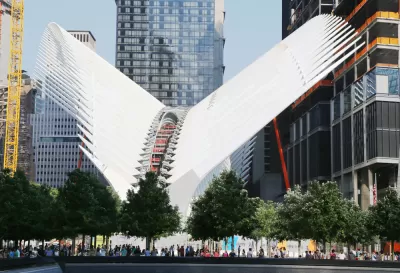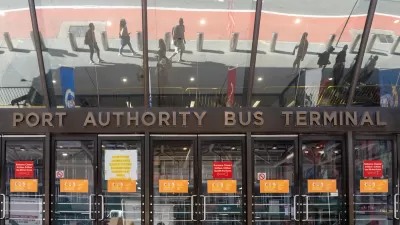A section of the $4 billion World Trade Center Transportation hub, designed by Santiago Calatrava, opened to the public today. The project has already inspired controversy, and will likely continue to do so.

Two of New York's leading design critics produced their reviews for the new World Trade Center Transportation, the day before a section of the building opened to the public. Michael Kimmelman and Paul Goldberger, writing for The New York Times and Vanity Fair, respectively, substantially differed in their opinions.
Headlining Kimmelman's review is the pronouncement of the project as a boondoggle:
The project’s cost soared toward a head-slapping, unconscionable $4 billion in public money for what, in effect, is the 18th-busiest subway stop in New York City, tucked inside a shopping mall, down the block from another shopping center.
Kimmelman does give credit to the Hub's main hall, or Oculus, as a "jaw-dropper" that "can almost — almost — make you forget what an epic boondoggle the whole thing has been." The review references Grand Central Station, speculates on the likelihood of the building achieving the ambitions of the project's supporters, and goes into a lot more detail about the design of the building.
A more optimistic pronouncement headlines Golberger's review: despite the project's cost, Calatrava has produced a "Genuine People's Cathedral." Here's how Goldberger introduces the effect of the new building:
Everyone knows that the World Trade Center Transportation Hub, designed by Santiago Calatrava, was insanely expensive—close to $4 billion at last count—and everyone knows that its design is just a little bit hokey, as if it were assembled out of dinosaur bones that were too big to fit into the Museum of Natural History. What most people don’t know is that if you can get yourself past all of that, and manage to push the dinosaur metaphors and the bird metaphors and all of that money out of your mind, you can have an architectural experience there that may renew your faith in the potential of the public realm in New York.
Golberger focuses in the review on how the project has reversed the course of a half-century of architecturally ambitious public projects, writing, "this is the first time in a half a century that New York City has built a truly sumptuous interior space for the benefit of the public." Goldberger also details the project's antecedents, the most recent of which, the Grand Promenade at the New York State Theater (now the David H. Koch Theater) at Lincoln Center, was built in 1964.
FULL STORY: Santiago Calatrava’s Transit Hub Is a Soaring Symbol of a Boondoggle

Maui's Vacation Rental Debate Turns Ugly
Verbal attacks, misinformation campaigns and fistfights plague a high-stakes debate to convert thousands of vacation rentals into long-term housing.

Planetizen Federal Action Tracker
A weekly monitor of how Trump’s orders and actions are impacting planners and planning in America.

In Urban Planning, AI Prompting Could be the New Design Thinking
Creativity has long been key to great urban design. What if we see AI as our new creative partner?

Florida Seniors Face Rising Homelessness Risk
High housing costs are pushing more seniors, many of them on a fixed income, into homelessness.

Massachusetts Budget Helps Close MBTA Budget Gap
The budget signed by Gov. Maura Healey includes $470 million in MBTA funding for the next fiscal year.

Milwaukee Launches Vision Zero Plan
Seven years after the city signed its Complete Streets Policy, the city is doubling down on its efforts to eliminate traffic deaths.
Urban Design for Planners 1: Software Tools
This six-course series explores essential urban design concepts using open source software and equips planners with the tools they need to participate fully in the urban design process.
Planning for Universal Design
Learn the tools for implementing Universal Design in planning regulations.
Gallatin County Department of Planning & Community Development
Heyer Gruel & Associates PA
JM Goldson LLC
City of Camden Redevelopment Agency
City of Astoria
Transportation Research & Education Center (TREC) at Portland State University
Jefferson Parish Government
Camden Redevelopment Agency
City of Claremont



























